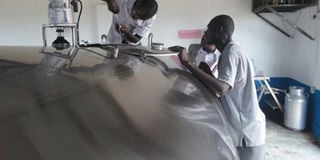Higher output, less costs: Dairy farmers benefit from coolers, trucks

An official inspects milk in a cooler unit. Dairy farmers in southwest Uganda are experiencing increased yields and less costs of doing business due to access to such technologies. PHOTO BY OTUSHABIRE TIBYANGYE
Dairy farmers in the southwestern region have reason to smile because of coolers and vehicles acquired through The Netherlands Government at a subsidised price to facilitate their participation in the milk cold chain.
“These have saved on costs of transporting milk to the markets since the milk can remain safe in the coolers for two days. They use less [energy] making them cost-effective and have since changed the dynamics of the milk market,” noted George Nuwagira, chairman, Uganda Crane Creameries Cooperative Union (UCCCU).
This was during a meeting with Dutch parliamentary committee on a tour to review Dutch-funded projects. It was at Rwempogo Dairy Farmers Cooperative Society.
He added that since the donation last year, the dairy farmers have benefitted via minimising the losses that plague the milk industry.
The farmers have been able to achieve tangible results that include timely delivery of milk to the market. Milk rejection has also come down due to timely delivery from farmers after empowerment.
Saves time
The chain is environmentally friendly since it uses a computerised system where the heat removed from the milk is used to heat the water that is used to clean the cooler and milk vessels and cans for farmers at the delivery centre.
During the flash period, when plenty of milk is produced ( the rainy season), farmers have been grappling with where to put the milk since the old coolers have been taking eight hours to cool the milk.
But now, it takes only three hours thus enabling transportation to the market and reusing the cooler in the afternoon.
Nuwagira said that incomes of farmers have tremendously increased, this is manifested in the increase of shares in the union.
“Farmers have been able to increase their shares to Shs2b, which has been injected in the milk factory currently under construction.”
Add value
Sharon Gesthuizen, who headed the delegation, was happy to note that the aid had been efficiently used. And that there is a follow-up to establish a training centre at AGDI farm in Kyakabunga village, 10 km off Lyantonde-Rushere road.
The farm, which has been chosen as a model farm in the region, belongs to Col Dick Bugingo, who was awarded the prize as a leading dairy farmer in the southwestern region in 2014.
Gesthuizen promised that the centre will not only train famers in good practices but also in value addition to milk products.
“This is intended to create jobs for the youth, get the youth to love farming and consume these products not only in Uganda but East Africa as a whole,” she said.
Col Bugingo pointed out that some of the biggest constraints facing dairy farmers are uncontrolled breeding system, poor milk yields, poor animal breeds, underfed animals and lack of interest in farming by the youth, among others.
However, he noted that he was happy that the intervention was a timely one, which has led farmers to take dairy farming to another level.
At the same occasion, Clayton Arinanye, the general manager, UCCCU, revealed that due to the increase in milk production in the region, dairy farmers will get 60 more coolers. He advised the farmers to maintain the coolers well, as they can last over 40 years.




